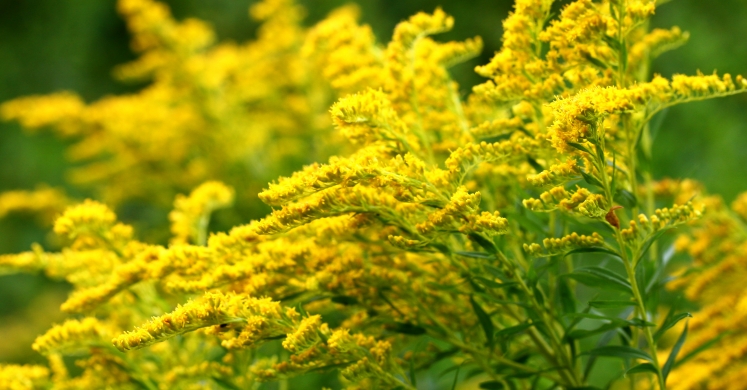Blog

#bioPGH Blog: Goldenrod
 A resource of Biophilia: Pittsburgh, #bioPGH is a weekly blog and social media series that aims to encourage both children and adults to reconnect with nature and enjoy what each of our distinctive seasons has to offer. From the best times to plant seasonal flora and enjoy their peak blooms, to astronomical events and creatures to keep an eye and ear out for, Phipps will keep you in the know with what’s going on in our environment!
A resource of Biophilia: Pittsburgh, #bioPGH is a weekly blog and social media series that aims to encourage both children and adults to reconnect with nature and enjoy what each of our distinctive seasons has to offer. From the best times to plant seasonal flora and enjoy their peak blooms, to astronomical events and creatures to keep an eye and ear out for, Phipps will keep you in the know with what’s going on in our environment!
One of the sure signs of fall is the blooming of goldenrod, which brightens fields and roadsides across Pennsylvania. If you visit Phipps this time of year, you’ll see about six different species near the welcome center or covering the hillsides around the Center for Sustainable Landscapes. Goldenrod is a native grassland perennial and crucial nectar and pollen source for a multitude of pollinators, but it often gets a bad rap as it’s often mistaken for that dreaded allergy-inducing plant, ragweed.
Goldenrod is the common name for Solidago species, a genus of over 100 species of the Aster family, most of which are native to North America. This genus produces tall spikes of showy flowers in varying yellow hues and can bloom from August to October. Goldenrod has heavy and sticky pollen (it is not airborne like ragweed pollen) and is pollinated by a variety of insects like bees, wasps, flies, beetles, and butterflies. Goldenrod spreads not only by seeds, but also underground stems called rhizomes. In this way, goldenrod forms clusters of stems that are genetically identical clones, contributing to goldenrod’s perception as a prolific, rapidly-spreading plant.
Goldenrod not only feeds pollinators, but also serves as habitat for insects like the gall fly, Eurosta solidaginis, and this relationship has become a classic story of natural selection. If you’re walking through a field of meadow in the late summer, you might notice hard globular growths in the goldenrod stems. These are called galls, and are a natural plant growth response to a gall fly larva feeding and growing in the stem. These galls are not the safe haven they may seem: the size of the gall (determined largely by the genetics of the fly) also influences one of the two sources of predation. If the gall is small, parasitoid wasps can penetrate the gall and oviposit (lay eggs) within the gall fly larva, but if the gall is large, it is more recognizable to birds, which will peck out the larva for a meal. With all these predators, how do gall flies survive from year to year? The opposing pressures from predators on gall size act as a form of stabilizing selection: galls in which larvae are most likely to survive tend to be of intermediate size – they are slightly too large for parasitoid wasps to penetrate, but small enough that they are less detectable to birds.
Connecting to the Outdoors Tip: This herbaceous perennial species loves meadows and grasslands and is suitable to backyard edges and is a late-summer nectar and pollen bonanza for native pollinators. Solidago species grow in a variety of environments, from swamps to dry grasslands, so consider your garden conditions before selecting the appropriate goldenrod species. Because ragweed pollen is prevalent when you’re gardening this time of year, this video shows you how to identify ragweed and reduce your pollen exposure. If you want to view some wildflowers this fall, join a hike in Ohiopyle State park this Sun., Sept. 18 or take a walk in Schenley Park to see what’s active this season on Sun., Sept. 25.
Continue the Conversation: Share your nature discoveries with our community by posting to Twitter and Instagram with hashtag #bioPGH, and R.S.V.P. to attend our next Biophilia: Pittsburgh meeting.
Resources:
Center for Sustainable Landscapes | Phipps Conservatory and Botanical Gardens
Pollinator Friendly Plants for Northeast US | USDA
Goldenrod Biology | Bucknell.edu
Selection on Eurosta’s Gall Size | University of Toronto
Xerces Society’s Five Plant to Help Pollinators | Storey.com
Ragweed and Goldenrod | Oklahoma Gardening on Youtube
Fall Wildflower hike | PA DCNR
Schenley Park Bird and Nature Walk | Learnyourland.com
Select photos © Wikimedia User: liz west (CC-BY 2.0); Wikimedia User: T. Parrish (CC-BY-SA 3.0)

